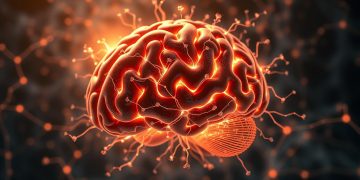“The mind is everything; what you think, you become.” – Buddha
This timeless wisdom underscores the profound impact of our thought patterns on our lives. Research by developmental biologist Bruce Lipton reveals that a staggering 95% of our daily behaviors are driven by unconscious decisions, highlighting the dominant role of the subconscious mind in shaping our actions.
When our habits align with our goals, they propel us toward success. However, when we’re entangled in undesirable habits, our lives are controlled by negative influences. This dichotomy raises a critical question: Why do we struggle to change our habits despite our best intentions and strongest willpower?
The answer lies in understanding the intricate relationship between our conscious efforts and the underlying subconscious mind. Lasting behavioral change requires more than just willpower; it demands a deeper understanding of our behaviors and the inner rewiring of our mind.
Key Takeaways
- Understanding the role of the subconscious mind in driving daily behaviors.
- The limitations of willpower in achieving lasting habit change.
- The importance of inner rewiring for sustainable behavioral transformation.
- Practical techniques for rewiring the subconscious mind.
- Gaining a deeper understanding of personal behavioral patterns.
The Hidden Driver of Your Daily Behaviors
The subconscious mind is the hidden driver behind most of our daily behaviors, shaping our actions without us even realizing it. Many of our daily actions are influenced by habits and decisions made below the threshold of conscious awareness.
Experts in the field offer varying perspectives on the extent of this influence. Charles Duhigg, author of “The Power of Habit,” suggests that unconscious decisions steer more than 40% of our daily behaviors. James Clear, in his book “Atomic Habits,” argues that this influence extends to over 50%. However, developmental biologist Bruce Lipton, in “The Biology of Belief,” takes it a step further, suggesting that a staggering 95% of our daily behaviors are driven by unconscious decisions.
The 95% Rule: How Your Subconscious Controls Your Life
According to Lipton’s “95% Rule,” the subconscious mind forms automatic routines to conserve mental energy, making these behaviors feel natural and effortless. This explains why we often act on autopilot, following established patterns even when they don’t serve our conscious goals.

Why Conscious Efforts Often Fall Short
Conscious efforts to change habits often fall short due to the disconnect between our conscious intentions and our deeper subconscious programming. The subconscious mind defaults to established patterns due to the “path of least resistance,” making it challenging to change behaviors through willpower alone. By understanding the role of the subconscious mind in driving our daily behaviors, we can begin to recognize the hidden patterns that influence our actions and make meaningful changes. For a daily practice to align with your vision and reset your subconscious, consider exploring resources like Align with Your Vision: A Daily Subconscious Reset.
Understanding the Two Minds: Conscious vs. Subconscious
At the core of human behavior are two minds: the conscious and the subconscious, each playing a unique role in our daily lives. According to Joseph Murphy, author of “The Power of Your Subconscious Mind,” the mind is made up of two parts: the conscious mind and the subconscious mind.
Your Conscious Mind: The Active Decision-Maker
Your conscious mind is your active mind, containing all the thoughts and feelings you’re aware of at any given moment. It judges your environment and makes choices and decisions based on these judgments. The conscious mind handles logical thinking, analytical reasoning, and willpower-based choices that you’re aware of making.
Your Subconscious Mind: The Automatic Pilot
In contrast, your subconscious mind is your passive mind, a reservoir of thoughts, feelings, and memories that lies beneath your conscious awareness. It regulates all of your bodily functions and records and stores your every experience, even when you’re not consciously paying attention. Over 90% of your brain’s activity takes place in your subconscious mind, making it a powerful influence on your daily behavior.
How These Two Systems Interact Daily
Throughout the day, your conscious and subconscious minds interact in complex ways. The conscious mind handles novel situations, while the subconscious manages routine tasks and emotional responses. The subconscious mind processes information much faster than the conscious mind, often overriding conscious intentions. This is why internal conflicts arise when your conscious goals contradict your subconscious programming, creating the frustrating experience of “knowing what to do” but not being able to follow through.
For instance, you might consciously decide to start a new exercise routine, but your subconscious mind, programmed with past experiences and habits, might resist this change. Understanding the interaction between your conscious and subconscious minds is crucial for making lasting changes in your behavior. As discussed in more detail on Affirmnosis, the subconscious mind plays a significant role in habit formation.
The key to harmonious interaction between these two minds lies in aligning your conscious goals with your subconscious programming. By doing so, you can leverage the power of your subconscious mind to support your conscious decisions, leading to more effective and lasting change.

- The conscious mind is responsible for logical reasoning and decision-making.
- The subconscious mind stores memories, habits, and emotional responses.
- The subconscious mind processes information thousands of times faster than the conscious mind.
By understanding and working with both your conscious and subconscious minds, you can gain greater control over your choices and decisions, ultimately leading to personal growth and transformation.
Why Your Subconscious Creates Habits in the First Place
Our brain’s tendency to create habits is an intrinsic part of its design, aimed at optimizing our daily lives. By understanding the underlying reasons for habit formation, we can better appreciate the complex mechanisms that drive our behaviors.
The Energy Conservation Principle
The human brain is wired to conserve energy by automating repetitive tasks. When we first learn a new skill or behavior, it requires significant conscious effort and mental energy. As we repeat this behavior, our brain creates a mental shortcut by converting the sequence of actions into an automatic routine. This process, known as “chunking,” allows us to perform tasks without devoting conscious thought to every detail, thereby saving mental energy for more complex tasks.

The Safety Mechanism: Keeping You in Your Comfort Zone
The subconscious mind also creates habits as a safety mechanism to keep us within our comfort zone. By establishing predictable patterns of behavior, our brain reduces the risk of encountering unfamiliar or potentially threatening situations. This mechanism is rooted in the brain’s desire to protect us from perceived dangers, even if the habits formed are not necessarily beneficial in the long run.
How Feedback Loops Reinforce Automatic Behaviors
Feedback loops play a crucial role in reinforcing habits through the brain’s reward system. When we perform a habitual behavior, our brain releases dopamine, a neurotransmitter associated with pleasure and satisfaction. This positive reinforcement creates a self-perpetuating cycle that strengthens the habit over time. Understanding this mechanism can help us devise strategies to modify or replace unwanted habits with more beneficial ones.
By recognizing that our subconscious mind creates habits to conserve energy, maintain safety, and respond to feedback loops, we can approach habit change with a more informed and compassionate perspective. This understanding empowers us to work with our brain’s natural tendencies rather than against them, leading to more effective and sustainable personal transformation.
The Willpower Trap: Why Force Alone Never Works
Willpower alone is insufficient for lasting habit change, as it neglects the underlying subconscious processes. When you rely solely on willpower, you’re attempting to override deeply ingrained habits without addressing the root causes of their existence.
The Limited Resource Problem
Willpower is a finite resource that depletes over time, much like a muscle that fatigues with repeated use. As the day progresses, your ability to exert self-control diminishes, making it increasingly difficult to maintain new habits. This limitation means that willpower alone cannot sustain long-term habit change efforts.
The Internal Conflict Between Goals and Programming
Your conscious goals often conflict with your subconscious programming. For instance, you may consciously decide to adopt a new habit, but your subconscious mind may resist this change due to previously stored routines. This internal conflict traps you in a cycle of attempting new habits and reverting to old ones.
| Aspect | Conscious Mind | Subconscious Mind |
|---|---|---|
| Role in Habit Change | Sets goals and intentions | Controls automatic routines |
| Response to Change | Open to new information | Resists change due to safety mechanisms |
| Influence on Behavior | Limited by willpower | Drives habitual behaviors |
Why Your Subconscious Resists Change
Your subconscious mind resists change because it perceives deviations from established patterns as potential threats to your survival and health. This resistance manifests as mental and physical discomfort, making it challenging to maintain new habits. Understanding this resistance is crucial to developing effective strategies for lasting habit change.
By recognizing the limitations of willpower and understanding the role of the subconscious mind in habit formation, you can begin to develop more effective strategies for achieving your goals. This involves working with your subconscious rather than against it, leading to more sustainable changes over time.
The Science of Subconscious Habit Change
Rewiring the subconscious mind is a scientifically supported process that can lead to profound personal change. According to Charles Duhigg, author of “The Power of Habit,” while you can’t delete unwanted automatic routines from your mind, you can override them with new automatic routines that align with the habits you want to practice through self-awareness and conscious control.
Neuroplasticity: The Brain’s Ability to Rewire
Neuroplasticity refers to the brain’s lifelong ability to form new neural connections, making subconscious reprogramming possible at any age. As explained by Napoleon Hill in “The Law of Success,” your subconscious mind is malleable and adapts to reflect your habitual thoughts. This means that by consciously controlling your habitual thoughts, you can retrain your subconscious mind into alignment with your desired habits.
Neuroplasticity is the foundation upon which lasting habit change is built. It allows the brain to reorganize itself by forming new neural pathways, a process that is essential for learning new habits and breaking old ones.
The Pain-Pleasure Principle in Habit Formation
The brain creates habits based on what it perceives will maximize pleasure and minimize pain, a principle that is fundamental to understanding why certain habits are formed and maintained. For example, habits that provide immediate gratification, such as checking social media, can become deeply ingrained because they activate the brain’s reward centers.
“The mind is malleable and adapts to reflect your habitual thoughts.” – Napoleon Hill
Creating New Neural Pathways for Lasting Change
Creating new neural pathways requires consistent repetition over time. This is why quick-fix approaches to habit change typically fail; they don’t allow for the gradual rewiring of the brain that is necessary for lasting change. Emotional states also play a significant role in this process, as combining logical approaches with emotional engagement accelerates the formation of new habits.
Research has shown that the brain consolidates new habits during sleep and rest periods, emphasizing the importance of consistency and patience in the rewiring process. By understanding and working with these natural mechanisms, individuals can achieve sustainable transformation.
7 Powerful Techniques to Reprogram Your Subconscious Mind
To achieve lasting change, it’s essential to rewire your subconscious mind using proven techniques. Your subconscious mind controls a significant portion of your daily behaviors and habits, making it a crucial area to focus on for those seeking personal growth and transformation. By applying the right strategies, you can reprogram your subconscious mind to support your goals and aspirations.
Visualization: Creating New Mental Movies
Visualization is a powerful technique for reprogramming your subconscious mind. It involves spending a few minutes each day imagining scenes that feature you achieving your desired outcomes. These scenes could include a beautiful home, a happy family, a successful business, or fulfilling relationships. As you visualize, reinforce the images with positive emotions such as joy, peace, gratitude, and love. Your subconscious mind will gradually adopt these mental pictures as reality.
Positive Affirmations: Changing Your Inner Dialogue
Positive affirmations are another effective method for reprogramming your subconscious mind. By consistently repeating positive statements, you can override negative subconscious programming. For example, affirmations like “I am capable and confident” or “I make healthy choices” can help reshape your subconscious beliefs. Repeat these affirmations daily, especially when you’re in a relaxed state, to maximize their impact.
Meditation: Accessing Deeper States of Mind
Meditation creates access to deeper brainwave states where your subconscious mind is more receptive to new programming. Regular meditation practice can help you tap into your subconscious mind, allowing you to reprogram deeply ingrained habits and thought patterns. Start with short meditation sessions and gradually increase the duration as you become more comfortable with the practice.
Environment Design: Controlling External Triggers
Your environment plays a significant role in triggering your habits. By designing your environment to support your goals, you can reduce the need for willpower and make positive change easier. For instance, if you’re trying to eat healthier, remove unhealthy snacks from your home and replace them with nutritious options. This simple change can help your subconscious mind adopt healthier eating habits.
Habit Stacking: Building on Existing Routines
Habit stacking involves building new behaviors by attaching them to existing automatic routines. This technique leverages the power of established neural pathways, making it easier to adopt new habits. For example, if you always brush your teeth as soon as you wake up, you can stack a new habit like flossing or meditating immediately after brushing your teeth.
Self-Awareness Practices: Becoming the Observer
Self-awareness practices help you become the observer of your thoughts and behaviors, creating the space needed for conscious choice. By being more aware of your actions and the motivations behind them, you can identify areas where your subconscious mind is driving unwanted habits. Journaling, mindfulness, and self-reflection are effective tools for developing self-awareness.
Consistent Small Actions: The Compound Effect
The power of consistent small actions should not be underestimated. By making tiny changes to your daily habits and maintaining them over time, you can achieve remarkable transformations. This approach is often more effective than trying to make drastic changes that are difficult to sustain. As Darren Hardy says, “Small, smart choices + consistency + time = radical difference”.
By incorporating these seven techniques into your daily routine, you can effectively reprogram your subconscious mind and achieve lasting change. Remember, the key is consistency and patience – with time, these practices will lead to significant improvements in your life and habits.
Overcoming Resistance: Dealing with Discomfort During Change
The process of rewiring the subconscious mind is inevitably accompanied by feelings of discomfort. This discomfort arises from the conflict between existing habits and new behaviors. Understanding and navigating this discomfort is crucial for successful habit change.
The Discomfort Zone
The discomfort zone is the space between old patterns and new habits where growth occurs. It’s essential to reframe this discomfort as a positive sign of progress rather than resistance to change. By doing so, individuals can begin to see discomfort as an opportunity for growth.
Techniques for Pushing Through Resistance
Several techniques can help individuals push through resistance, including mindfulness practices, emotional regulation strategies, and cognitive reframing tools. These techniques enable individuals to manage their discomfort and continue moving forward with their habit change.
Signs That Your Subconscious Is Beginning to Shift
As the subconscious mind begins to shift, individuals may experience energy fluctuations, emotional releases, or temporary setbacks. These signs indicate that the subconscious is adapting to new habits and behaviors. Recognizing these signs can help individuals stay motivated and continue their progress.
By understanding the discomfort zone, employing techniques to push through resistance, and recognizing the signs of subconscious shift, individuals can successfully navigate the challenges of habit change and achieve lasting transformation.
Conclusion: The Journey to Sustainable Transformation
The path to lasting change is rooted in aligning your conscious goals with your subconscious programming. To achieve success, it’s crucial to reprogram your mind by setting clear goals and practicing consistency. Your subconscious mind is an organized domain that demands clarity of purpose.
By applying the techniques discussed, such as visualization and positive affirmations, you can rewire your brain and develop healthier habits. This journey requires patience and persistence, as neural pathways strengthen gradually through consistent practice.
Approach habit change with curiosity and self-compassion, rather than judgment and force. By doing so, you’ll create the optimal conditions for your subconscious mind to cooperate, leading to profound life changes over time.
FAQ
What is the role of the subconscious mind in forming daily behaviors?
The subconscious mind controls a significant part of daily behaviors, with research suggesting it influences up to 95% of actions, making it a crucial aspect to address when seeking personal growth or transformation.
How do conscious efforts to change habits often fall short?
Conscious efforts to change habits often fail because they don’t address the underlying subconscious programming, leading to internal conflict between goals and existing mental patterns.
What is the energy conservation principle in habit formation?
The energy conservation principle suggests that the mind creates habits to conserve energy by automating repetitive tasks, freeing up mental resources for more complex decisions.
How can one reprogram their subconscious mind for lasting habit change?
Techniques such as visualization, positive affirmations, meditation, environment design, habit stacking, and self-awareness practices can help reprogram the subconscious mind, leading to more sustainable changes.
Why does willpower alone fail to achieve lasting habit change?
Willpower is a limited resource that can be depleted, and relying solely on it to change habits can lead to failure due to the internal conflict between conscious goals and subconscious programming.
What is the significance of neuroplasticity in habit formation and change?
Neuroplasticity allows the brain to rewire and form new neural pathways, making it possible to create lasting changes in habits and behaviors by consistently practicing new actions and thoughts.
How can one overcome resistance and discomfort during the habit change process?
Understanding the discomfort zone, using techniques to push through resistance, and recognizing signs that the subconscious is beginning to shift can help individuals overcome the challenges associated with changing habits.




























































